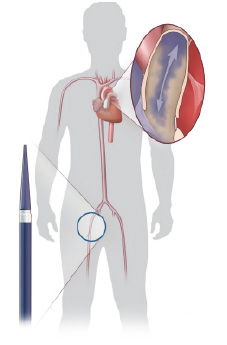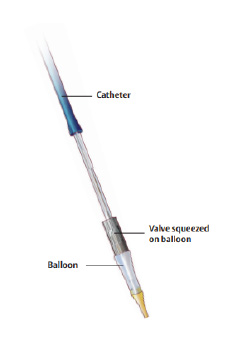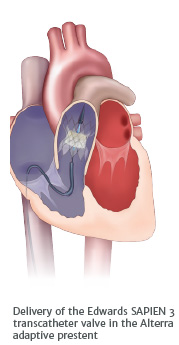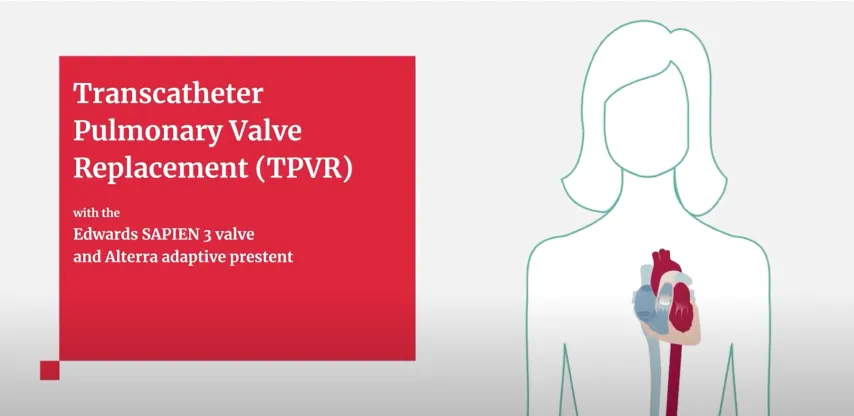Transcatheter Pulmonary Valve Replacement (TPVR) With the Edwards SAPIEN 3 Valve and Alterra Adaptive Prestent System
TPVR is a less invasive treatment option for patients who typically face the burden of multiple open-heart surgeries, often beginning at birth. The Edwards SAPIEN 3 valve with the Alterra adaptive prestent system, could help people with congenital heart disease (CHD) who have pulmonary regurgitation due to a prior procedure to fix their pulmonary valve or right ventricular outflow tract (RVOT).
Most CHD patients will typically require multiple open-heart surgeries throughout their lifetimes. With each open-heart surgery, your surgical risk increases. However, with the less invasive option of TPVR with the Edwards SAPIEN 3 valve and Alterra adaptive prestent system, it is possible that you will need fewer repeat surgeries, as well as return home sooner to the activities you love.
Download BrochurePatients who receive the Edwards SAPIEN 3 pulmonic valve and Alterra adaptive prestent may experience the following:

TPVR could delay your next open-heart surgery

TPVR patients experience improved heart function within the first year of treatment
The Edwards SAPIEN 3 Pulmonary Valve With the Alterra Adaptive Prestent System
This technology is a part of Edwards’ long-standing leadership in patient-focused innovations for structural heart disease. Edwards has been helping critically ill patients for over 60 years.

Alterra Adaptive Prestent
The prestent is designed to help make your RVOT suitable for implanting the Edwards SAPIEN 3 transcatheter heart valve. The Alterra adaptive prestent works as a landing zone for the Edwards SAPIEN 3 pulmonary valve within the RVOT. The prestent frame is made from metal and has a fabric covering with designated inflow and outflow ends.

Edwards SAPIEN 3 Valve
The valve is designed to work like your pulmonary heart valve and help make your valve and heart work as it is intended. The Edwards SAPIEN 3 transcatheter heart valve is made up of three main components: three leaflets made from the tissue of a cow’s heart, a metal frame, and a fabric skirt. Together with the Alterra adaptive prestent, the Edwards SAPIEN 3 pulmonary valve should begin working immediately after it is implanted.
TPVR With the Edwards SAPIEN 3 Valve and Alterra Adaptive Prestent System

Who Should Have the Procedure?
The Edwards SAPIEN 3 valve with the Alterra adaptive prestent system is a minimally invasive treatment option, designed to help treat severe pulmonary regurgitation in children, adolescents, and adults with a native or surgically repaired RVOT.

Who Should Not Have the Procedure?
The Edwards SAPIEN 3 valve with the Alterra adaptive prestent system should not be used with anyone who cannot tolerate medications that thin the blood or prevent blood clots from forming or who have an active infection in the heart or elsewhere.
Steps of the TPVR Procedure With the Edwards SAPIEN 3 Pulmonary Valve and Alterra Adaptive Prestent System
Be sure to tell your doctor if you are taking any medications or have any allergies. Your doctor will also explain the procedure and answer any questions you might have.
Steps of the TPVR procedure



Life After Your TPVR Procedure
It is important to understand that every patient is different in how they recover. You can expect to spend a day or two in the hospital after your procedure. Most patients should begin walking soon after their procedure. Before you leave the hospital, your doctor will explain your aftercare plan. You will be given specific instructions to help with your recovery, including when to return to exercise, as well as any medicine you need to take.
It is important to carefully follow your doctor’s directions, especially if you need to take any blood-thinning medication. You should start feeling better soon after TPVR. It can take about a week before you return to normal, everyday activities. Regular checkups with your doctor are essential. Take your medications as instructed and be sure to keep all follow-up appointments with your doctor.
Potential Benefits of the Edwards SAPIEN 3 Pulmonary Valve
Clinical data has shown signs of improvement in health up to six months. That means a lot in terms of improved quality of life, including:

Delay of next open-heart surgery

Improved heart function

Ability to care for yourself

Return to everyday activities

Average length of stay for patients who received TPVR with the Edwards SAPIEN 3 Valve:
1-2 days
How long your tissue valve will last depends on many patient factors and medical conditions. Follow all care instructions to ensure the best possible results. The Edwards SAPIEN 3 pulmonic valve has been tested in a laboratory to mimic 5 years of use without failure. Regular follow-ups will help your doctor know how your valve is working.
Watch Real Patient Stories
See how TPVR helped patients to delay their next open-heart procedure
Watch Video

Want To Stay Informed About the Latest Pulmonary Therapies?
Want To Stay Informed About the
Latest Pulmonary Therapies?

